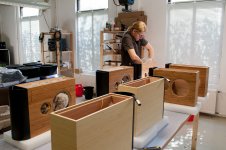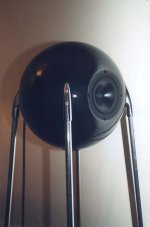When I go to the Vienna State Opera House and sit in the first row with the orchestra pit below, I am definitely able to hear pin-point imaging.
Ha, i think you are right at pointing to the importance of sitting at the right place. Listening to a live acoustic event can be extremely disappointing if you sit at a wrong place and get no soundstage no imaging at all, total acoustic chaos even with chamber music, a piano and a cello. Guys like me who buy their tickets at the last moment have plenty of experiences of these to report...
At least no that clean, simplified and tidy fake soundstage that good stereo recordings deliver for a detailed easy on ears, and after all almost credible reproduction.
All our progress in the field of science is the result of research, what many years ago it seemed science fiction today is reality.
Everything can be improved...
Ok, i think measurements can help assess the technical performance of loudspeakers, which in turn can help assess the subjective performance of sound reproduction.
But i don't believe that stereo can be improved beyond any limit, and reproduction of a real acoustic soundfield is beyond its scope, same as it is for mono, and any multichannel system, even Atmos... Scope have to be humble: try imitate the experience of the real thing in a convincing way with limited means.
Last edited:
Bill were you in the room for the Walsh redos at the Dayton Speaker contest that year I was a judge there? Maybe you don't remember them, but Don Keele and I were really surprised by them. They had an astonishing image, like no other speaker we heard that day. A sort of pinpoint image that I've rarely heard - and that GDO would probably declare "Rubbish!"
Of course they were a long way from any walls. In that setting they worked amazingly well.
I do remember them, and thought they sounded remarkable, but mostly in tonality. But I actually heard no image at all from them, they sounded like music playing "somewhere in the front of the room" natural and life-like but no instruments defined in position. Perhaps that was because of my seating position.
(I do recognize that imaging in stereo is largely better than in real life much of the time).
(I do recognize that imaging in stereo is largely better than in real life much of the time).
Different speakers tend to create different soundstages. I find wide dispersion ones provide a more diffuse soundstage more in the center and farther in distance, whereas narrow dispersion brings it closer, wider and yes... better than life, i might say too good to be true for my taste...
In DIY yes, but..........
Sometimes , often perhaps, commercial designs are what some diy people would do with a budget and a team of people behind them . There are many diyers with great ideas but the more complex are strung out over years and years or never get completed. ,
Interesting - thanks!I do remember them, and thought they sounded remarkable, but mostly in tonality. But I actually heard no image at all from them, they sounded like music playing "somewhere in the front of the room" natural and life-like but no instruments defined in position. Perhaps that was because of my seating position.
I am usually most sensitive to tonal balance over anything else, but don't particularly remember the tonal balance of these. Go figure. I do know that Don, Jerry and I were all quite struck with the image and commented on it at the time, then put that in our notes. By far the most uncanny pin-point of all the speakers we heard, they really stood out. It must have been our good seating position, if you didn't get that effect seated farther back in room. Valuable info.

Yes, I agree. A year or so after that meet in Dayton I was at an Acoustical Society meeting where both Keele and Danley brought their pet speakers, the CBT and the SH50.Having a single point source (rather than spread out drivers) does make for a solid image if you get enough direct energy.
I've sent 20+ years listening to some guy talk to a room full of people via a lavalier mic and 2 speakers and know that sound by heart because it's my job. In this case the SH50s were the PA. I have never heard a phantom image of a voice like the SH50s did in that room. I don't know if anyone else really noticed, but I sure did! Just about perfect.
That said i must also say that i apreciate the efforts made by Keyser to openly share his personal opinions about loudspeaker design, beyond marketing hype.
I'd say it is only presentation that differenciates the two. Talk in any way that the listener feels is a cliche and it will be dismissed as hype, good engineering or not.
There's room to discuss it all and then sort out the hype from real engineering by merit of the idea alone, not it's presentation.
Taking this back to the OP's original question and taking our answer in both the wide and narrow baffle design directions - obviously there is not a "best" approach as 24 pages of discussion has shown - what ARE practical examples of baffle design with at least elements that help with problems with diffraction effects? We did have some already earlier in the thread.
Grimm Audio LS1 has the positioning of the tweeter more central to the relatively wide baffle and beneath the mid so that a curved edge nearest the tweeter is more aesthetically pleasing on the bottom rather if it were on the top.
http://www.jjumper.org/images/salon-hifi14-050.jpg
Grimm Audio LS1 has the positioning of the tweeter more central to the relatively wide baffle and beneath the mid so that a curved edge nearest the tweeter is more aesthetically pleasing on the bottom rather if it were on the top.
http://www.jjumper.org/images/salon-hifi14-050.jpg
Member
Joined 2009
Paid Member
Grimm Audio LS1 has the positioning of the tweeter more central to the relatively wide baffle and beneath the mid so that a curved edge nearest the tweeter is more aesthetically pleasing on the bottom rather if it were on the top.
And it's filled with real wool!
(way more important than goofing around with corner edges is what happens with the backwave)
Attachments
Ive seen a few examles recently of full range drivers in salad bowl spheres, is this a preferred option?
Yes, if the range is full enough and the sphere large enough.
Sputnik from 1997:
Attachments
Ive seen a few examles recently of full range drivers in salad bowl spheres, is this a preferred option?
But with a sphere enclosure, you have 1 severe resonance peak.
I recently finished my speaker set with 10F/8424 in minimum diffraction sphere. 20cm diameter, around 2l sealed filled with wool. My measuring space is limited but I'll try to measure them if anyone is interested. Which measurements would be preferred?
DIY Speaker Set - Album on Imgur
Last edited:
But with a sphere enclosure, you have 1 severe resonance peak.
Unless really large sphere, that standing wave is high in frequency and quite easy to absorb.
Last edited:
- Home
- Loudspeakers
- Multi-Way
- What are some good example of baffle design to improve diffraction


